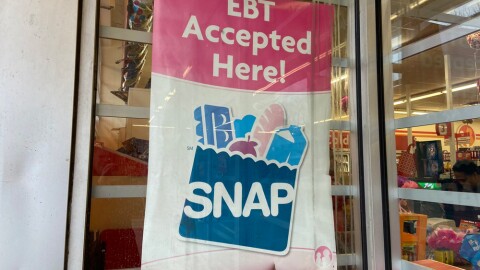The Trump administration said Monday that after a pair of judges ruled that officials had to keep the food aid program running.
At about the same time, Columbus and Franklin County leaders gathered at St. Stephens Community House in South Liden to announce more than $3 million in support for recipients of the program whose benefits lapsed over the weekend because of the federal government shutdown.
Columbus Mayor Andrew Ginther said the local resources would not fill the gap in need for long.
"What we're talking about is a short-term approach to a crisis, but this is not sustainable," Ginther said.
Funding food banks
The city of Columbus and Franklin County Commissioners each gave $500,000 to Mid-Ohio Food Collective to address immediate hunger.
Matt Habash, president of Mid-Ohio Food Collective, said 1.4 million Ohioans, including around 320,000 people in the 20 counties MOFC serves, rely on SNAP benefits.
"Please understand, food banks cannot make up for the loss of SNAP benefits. SNAP, which many of you know as food stamps, is America's first and best defense against hunger," Habash said.
Habash was grateful for the support of the city and the county, and noted that the state of Ohio had also provided temporary funding for food banks to help Ohio's poorest residents.
"But the sheer size of SNAP and the pain of its loss will still be felt until the federal government finishes its work," Habash said. "For now, it's up to Ohioans to help one another."
The federal government had been providing about $31 million in SNAP benefits to people in Franklin County every month.
"I don't have $31 million lying around," Ginther said. "Neither does (Franklin County) Commissioner Crawley or her colleagues. Neither Does Matt Habash. This isn't the role of city government or county government or the private sector or the nonprofit sector. This is the role of the federal government."
Nationally, the SNAP program costs the federal government about $8 billion a month. Monday, the Trump administration said it would pay recipients about half the amount they usually get, from an Agriculture Department contingency fund.
"Philanthropy cannot make up federal cuts. This is about SNAP as the first line defense."- Matt Habash, president and CEO of Mid-Ohio Food Collective
Food for kids and rent assistance
In addition to the funding for food banks, Ginther said the city is giving $125,000 to Columbus City Schools to distribute packaged meals and shelf-stable foods to students and families.
Another $40,000 will go to the Children's Hunger Alliance for 1,500 meal boxes for after-school programs. Lifecare Alliance will get $30,000 to provide frozen meals and snack items at Columbus Recreation and Parks Mobile Produce Markets.
Ginther touted a $2 million emergency rent assistance program for extremely low-income households. That money had already been set aside before SNAP benefits lapsed, but the city said it's moving up the program's launch.
Columbus Water & Power is also temporarily pausing utility shut-offs and waiving late payment fees.
"No one should have to choose between rent and food," Ginther said.
Funding for the relief programs comes from the city's general fund and several grant funds, according to Ginther. The county's portion of funding for MOFC comes from its general fund contingency budget, Commissioner Erica Crawley said.
"We're not waiting on anyone else to fix this for us," Crawley said. "We're moving right now with our city, nonprofits, food banks, schools and faith partners, because no one should ever go hungry while hope is within reach."
Other resources
Ginther reminded residents that other resources are available for people who receive SNAP benefits.
As part of an ongoing program in the city, SNAP recipients can also receive one-time bill credits of $65 for water and $50 for power, plus an ongoing monthly 25% discount.
Central Ohio Transit Authority offers a 50% discount on fixed-rate fares for SNAP recipients who are enrolled in COTA's digital payment system.
"These programs aren't the same as food assistance, but they can help a household dollar go a little bit further," Ginther said.
Columbus Public Health will also distribute frozen meals, produce, shelf-stable foods, hygiene products and diapers to Columbus SNAP recipients at mobile produce markets this week at the following locations:
- Thursday, Nov. 6, at Glenwood Recreation Center, 1888 Fairmont Ave.
- Friday, Nov. 7, at Scioto-Southland Recreation Center, 3901 Parsons Ave.
- Monday, Nov. 10, at Linden Recreation Center, 1350 Briarwood Ave.
- Wednesday, Nov. 12, at Far East Recreation Center, 826 Latimer Drive.
Columbus Recreation and Parks after-school programs will also continue to provide meals to participants.






